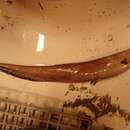Diagnostic Description
provided by Fishbase
Presence of palatine and dentary teeth in two or more rows. Numerous dorsal spines. Small specimens are pale tan or pale bluish gray, large specimens are dark brown (Ref. 37108).
- Recorder
- Cristina V. Garilao
Morphology
provided by Fishbase
Dorsal spines (total): 5 - 12; Dorsal soft rays (total): 2; Anal spines: 14 - 17; Analsoft rays: 125 - 145; Vertebrae: 225 - 239
- Recorder
- Cristina V. Garilao
Trophic Strategy
provided by Fishbase
Found on the continental slope (Ref. 75154). Not uncommon in depths around 180 m off Iceland and Greenland. Individuals with nearly ripe eggs have been found in late autumn off Iceland. Mostly found at depths well below 200 m, but enters slightly shallower water on Grand Banks in Canada. Feed primarily on sea anemones.
- Recorder
- Drina Sta. Iglesia
Biology
provided by Fishbase
Benthopelagic (Ref. 58302) and epibenthic (Ref. 58426). Not uncommon in depths around 180 m off Iceland and Greenland. Individuals with nearly ripe eggs have been found in late autumn off Iceland. Mostly found at depths well below 200 m, but enters slightly shallower water on Grand Banks in Canada (Ref. 7251). Feeds primarily on sea anemones (Ref. 4449).
Importance
provided by Fishbase
fisheries: of no interest
Snub-nosed spiny eel
provided by wikipedia EN
The snub-nosed spiny eel, Notacanthus chemnitzii, is a member of the family Notacanthidae, the deep-sea spiny eels, which are not true eels (Anguilliformes). The snub-nosed spiny eel exists in waters all over the world, except in the tropics,[1] ranging in color from light tan to bluish grey in small ones to dark brown in large ones.[1] Its primary food is sea anemones.[1] The eel usually lives in deep waters, mostly more than 200 m below the surface.[1]
References

- license
- cc-by-sa-3.0
- copyright
- Wikipedia authors and editors
Snub-nosed spiny eel: Brief Summary
provided by wikipedia EN
The snub-nosed spiny eel, Notacanthus chemnitzii, is a member of the family Notacanthidae, the deep-sea spiny eels, which are not true eels (Anguilliformes). The snub-nosed spiny eel exists in waters all over the world, except in the tropics, ranging in color from light tan to bluish grey in small ones to dark brown in large ones. Its primary food is sea anemones. The eel usually lives in deep waters, mostly more than 200 m below the surface.
- license
- cc-by-sa-3.0
- copyright
- Wikipedia authors and editors
Diet
provided by World Register of Marine Species
Feeds primarily on sea anemones
North-West Atlantic Ocean species (NWARMS)
- license
- cc-by-4.0
- copyright
- WoRMS Editorial Board
Distribution
provided by World Register of Marine Species
Iceland to Gulf of Mexico
North-West Atlantic Ocean species (NWARMS)
- license
- cc-by-4.0
- copyright
- WoRMS Editorial Board
Habitat
provided by World Register of Marine Species
A bottom- dwelling species, found at depths of 125- 2500 m.
North-West Atlantic Ocean species (NWARMS)
- license
- cc-by-4.0
- copyright
- WoRMS Editorial Board
Habitat
provided by World Register of Marine Species
nektonic
North-West Atlantic Ocean species (NWARMS)
- license
- cc-by-4.0
- copyright
- WoRMS Editorial Board
Habitat
provided by World Register of Marine Species
Known from seamounts and knolls
Stocks, K. 2009. Seamounts Online: an online information system for seamount biology. Version 2009-1. World Wide Web electronic publication.
- license
- cc-by-4.0
- copyright
- WoRMS Editorial Board

